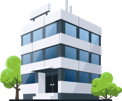iBwave System Design: Prevent 8 Common Network Installation Mistakes
Commercial iBwave Design Services Can Solve All Your Cellular System Issues
Installing a signal amplification system to the latest wireless standard in a large building is harder than you might think at first.
Wireless networks are full-on utilities at this point, every bit as essential to a functional business as the traditional triumvirate of water, power, and gas. They deserve to be treated with the same reverence as your building’s electrical or pipe grid, and that means professionally.
iBwave Design is the industry-standard software for designing in-building wireless networks, whether they are distributed antenna systems (DAS) or a more common bi-directional amplifier or WiFi system. It separates itself from its competition by handling all the calculations for coax cable loss, building structure, power sources, and other signal sources to provide the most accurate, realistic expectation of wireless coverage for a solution design.
Installing your system without using iBwave, or any kind of system design at all, can result in problems. As these systems are expensive, it only makes sense to get one of these designs to ensure you get your money’s worth.
We fix poor cell phone signal! Find the right signal booster for you:




Here are the most common mistakes we see:
1. Using the Wrong Amplifier(s)

Not taking advantage of a system design can leave you with not enough power to get the coverage you need. Combined with some of the other mistakes on this list, this will leave you feeling underwhelmed with your cellular solution, and considering the cost involved, this is the last thing you want.
This is easily the most common issue we find, but is also the most preventable, as a thorough consultation and system design will give you a greater understanding of an amplifier’s strengths and weaknesses and how many you will need to get the desired coverage.
2. Using the Wrong Antennas or Cable

The second most common issue that can be rectified with a system design is using the wrong equipment. The amplifier is just one part of a comprehensive solution for either cellular or WiFi, with the antennas and cabling being equally important.
There are really two sides to this issue. First is getting the wrong equipment, and the other is having it installed poorly. You could have the highest-quality cable, but if it’s installed poorly, you won’t see much change in your network. Likewise, if you have everything installed perfectly but have low-quality cable or a sub-optimal antenna, you won’t be getting the most out of your system.
Our iBwave designs will ensure you get the best equipment at the lowest price possible, and our complete installation service will make sure it’s installed correctly.
3. Placing Indoor Antennas in Poor Spots

If you place your indoor antennas haphazardly, you won’t see much change. Antennas should ideally be placed where need is greatest, or having the widest coverage range. Even if installed correctly, placing a panel antenna in a wide room or a dome antenna in a corner or a room with high ceilings isn’t going to get you the coverage you want. Combined with the next two points, these present the most frequent challenges for amateur installers (and some of the less reputable pros).
An iBwave system design solves this problem by laying out exactly what goes where before a dime is spent on equipment, and you’re able to see a completed heatmap of where the antennas will be placed and the coverage they’ll provide.
4. Not Factoring in Layout

A similar issue to the one above, but even more complex. Depending on how your building is laid out, installing your system can be made much more difficult. You may have wide open areas without drop tile. You may have extremely high ceilings. You may not have any convenient places to place an antenna. All this sound familiar?
Where it gets more difficult is with cable runs. Factoring these into your installation makes understanding the building layout paramount. It takes professional designers to pull off cable runs for many complex buildings. With our iBwave system design services, we’ll make sure those cables are placed optimally, and you can see where we propose to run them with a complete heatmap.
5. Not Factoring in Building Material

This goes hand in hand with layout, but is another factor to consider. What is each wall made of in your building? Some might be firewalls, made of thick concrete. Others may be drywall. Maybe you’ve got an open area with glass windows. Are they regular glass, or low-e glass? All of this matters for a network extender. Each of these building materials puts up a different level of resistance to RF frequencies, and these need to be taken into account.
It is, quite frankly, a difficult job, but that’s what iBwave is for. After you order a design, you’ll see how much penetration you’ll get from antennas placed outside key areas, and be able to decide if that’s acceptable for you.
6. Optimizing only WiFi or Cellular, But Not Both

While we specialize in cellular networks here at Wilson Amplifiers, we can design WiFi systems as well. Having both in this day and age is critical, especially for large companies, as bandwidth becomes a bigger concern the more employees and guests rely on these networks.
Connectivity is critical, and not having both network options fast and available makes your employees’ jobs harder.
7. Not Accounting for Interference and Noise

In many cases, you’ll find getting clear signal difficult due to network interference or noise. These can be caused by many things: high-powered devices, too many RF signals in your area, electromagnetism, etc. All of these things make extended travel for your cellular service more difficult, and when it does manage to hit your phone, you’re as likely to hear static as a dial tone.
An iBwave system design factors in every possible noise-producing device in an area, starting with how much SNR (signal-to-noise ratio) is present on the received outside signal, and accounting for every conceivable device that could intercept your amplified signal, whether that be a high-powered generator or the unassuming MacBook in the corner cubicle.
8. Not Optimizing for the Desired Carriers

A tricky one. While our amplifiers are guaranteed to boost all the most common bandwidths across all major North American carriers, their effectiveness depends on the strength of the outside signal. This means that sometimes, getting Verizon signal may be a breeze, but if you need T-Mobile, it can be a challenge. Often, amateur installers optimize around one carrier, then find no improvement on the others.
With the rise of bring your own device (BYOD) policies around the workplace, this no longer flies, as each employee brings their own carrier to the office or factory floor. An iBwave system design takes into account all outdoor signal readings for all major carriers, and ensures the required coverage is placed where you want it.
Have a Business that Needs an iBwave Design or Commercial Installation?
Call us at 1-800-919-7442 or send us an email for a free consultation.
Interested in Learning More? Check Out Our Signal Boosting Info Center


Money Back Guarantee

Technical Support